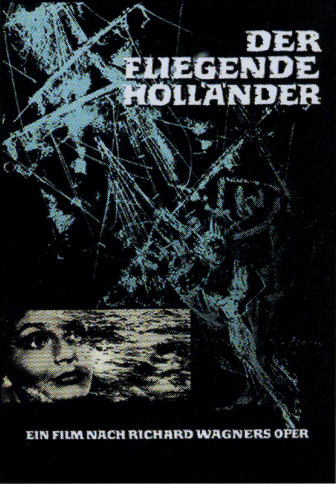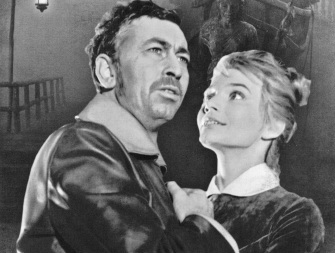Der fliegende Holländer (1964)

For centuries, the ancient nautical folk tale Der fliegende Holländer ("The Flying Dutchman"), about a ghost ship cursed to sail the oceans for eternity, has inspired writers, painters, songwriters, composers, and filmmakers. Joachin Herz's adaptation of his 1962 staging of Richard Wagner's opera Der fliegende Holländer breaks with filmed opera orthodoxy from the start by having actors lip-synch to the actual singers. Surreal images and not-so-subtle nods to German expressionism abound; and the aspect ratio expands from 4:3 to widescreen as the story shifts from "reality" to fantasy and then shrinks back again, a variation on the structure of a beloved Hollywood fantasy film.
Though largely overlooked until recently, Der fliegende Holländer is one of the most visually striking and unusual filmed operas of the sixties. It is also, purportedly, the only film made in the German Democratic Republic to feature depictions of the living dead.
The basis of Wagner's 1843 opera is taken from an account of the Flying Dutchman legend in a satirical novel by Heinrich Heine. Heine's version had added possible salvation for the captain of the cursed vessel: every seven years, he is allowed to look for the love of a faithful woman who will break the spell. Senta (Anna Prucnal), the daughter of Daland (Gerd Ehlers), a well-to-do ship owner, fantasizes about the captain of the Flying Dutchman (Fred Düren) and yearns to save him from his eternal mission. On a fishing expedition, Daland and his crew are caught in a storm and find they have anchored near the Flying Dutchman. On shore, the macabre vessel's captain promises riches to Daland in exchange for Senta's hand in matrimony.
With the townspeople present, Senta and the captain announce their impending wedding. The town's young people celebrate the return of Daland's fishing boat with drunken revelry until their party is crashed by the zombie-like crew members from the Flying Dutchman. Panic ensues and, one eventful revelation later, the phantom ship sets sail once again.
Der fliegende Holländer was made to attract viewers who were not opera lovers, claimed Herz, which may explain why actors star instead of singers. It was filmed on location and on movie sets instead of a theater stage, escaping the confining studio appearance of most filmed opera. And it's readily apparent that Herz' Der fliegende Holländer was intended more as a film than a record of a performance. The dramatic black and white compositions by cinematographer Erich Gusko, which evoke Sven Nykvist's work for Bergman in Through A Glass Darkly and others, are often stunning, and the use of double exposure and other effects enhance the folk tale's dreamlike quality.
Though largely overlooked until recently, Der fliegende Holländer is one of the most visually striking and unusual filmed operas of the sixties. It is also, purportedly, the only film made in the German Democratic Republic to feature depictions of the living dead.
The basis of Wagner's 1843 opera is taken from an account of the Flying Dutchman legend in a satirical novel by Heinrich Heine. Heine's version had added possible salvation for the captain of the cursed vessel: every seven years, he is allowed to look for the love of a faithful woman who will break the spell. Senta (Anna Prucnal), the daughter of Daland (Gerd Ehlers), a well-to-do ship owner, fantasizes about the captain of the Flying Dutchman (Fred Düren) and yearns to save him from his eternal mission. On a fishing expedition, Daland and his crew are caught in a storm and find they have anchored near the Flying Dutchman. On shore, the macabre vessel's captain promises riches to Daland in exchange for Senta's hand in matrimony.
With the townspeople present, Senta and the captain announce their impending wedding. The town's young people celebrate the return of Daland's fishing boat with drunken revelry until their party is crashed by the zombie-like crew members from the Flying Dutchman. Panic ensues and, one eventful revelation later, the phantom ship sets sail once again.
Der fliegende Holländer was made to attract viewers who were not opera lovers, claimed Herz, which may explain why actors star instead of singers. It was filmed on location and on movie sets instead of a theater stage, escaping the confining studio appearance of most filmed opera. And it's readily apparent that Herz' Der fliegende Holländer was intended more as a film than a record of a performance. The dramatic black and white compositions by cinematographer Erich Gusko, which evoke Sven Nykvist's work for Bergman in Through A Glass Darkly and others, are often stunning, and the use of double exposure and other effects enhance the folk tale's dreamlike quality.

As the ghostly Captain, actor Fred Düren makes a grand entrance at Senta's house: in silhouette in the background, his collar raised, he appears as a vampire. Anna Prucnal's fantasy-prone Senta cowers timidly in the shadow of her father, suggesting a troubled home, but beams blissfully when imagining her meeting with the spectral seaman. Ten years later, Prucnal would herself play the captain of a barge in Dusan Makavejev's Sweet Movie, which created such controversy over its perceived pornographic imagery and anti-communism that Prucnal was banned for years from returning to her native Poland.
Der fliegende Holländer was screened at Goethe Institut in Washington, DC on December 9, 2013. It is available on DVD from Germany's Icestorm Video (www.icestorm.de). The DVD is in German with no English subtitles, but can be easily followed by consulting a synopsis of the opera. Extras include an interview with music scholar Dr. Kristel Pappel-Herz and a segment from the August 1964 episode of the German television series "Der Augenzeuge" (The Eyewitness) with behind-the-scenes clips from the film's production, although these, too, are in German without subtitles.
Der fliegende Holländer was screened at Goethe Institut in Washington, DC on December 9, 2013. It is available on DVD from Germany's Icestorm Video (www.icestorm.de). The DVD is in German with no English subtitles, but can be easily followed by consulting a synopsis of the opera. Extras include an interview with music scholar Dr. Kristel Pappel-Herz and a segment from the August 1964 episode of the German television series "Der Augenzeuge" (The Eyewitness) with behind-the-scenes clips from the film's production, although these, too, are in German without subtitles.